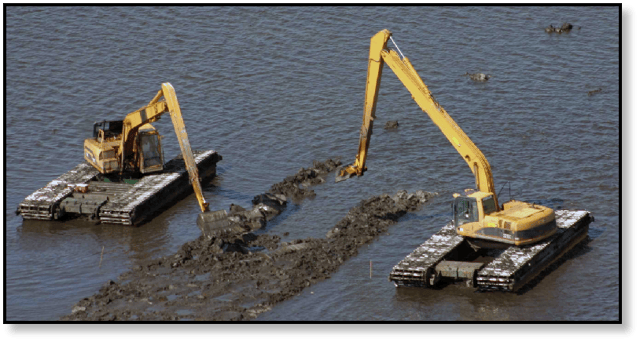
There are two approaches to excavating underwater. The first is through the use of amphibious excavators which work primarily in swamps, marshlands, and relatively shallow water. This blog post focuses on the second approach: excavators used in deeper waters which are partially (or totally) submerged.
Underwater Excavators versus Amphibious Excavators
Amphibious excavators, also referred to as swamp excavators or floating excavators, are used for shallow water tasks only and are not intended to be fully submerged underwater. They perform a variety of tasks, including flood maintenance works, maintenance of waterways, and roadbuilding through wetlands. Underwater excavators, on the other hand, are designed to be used in deep water and may operate while completely submerged. While they can perform tasks similar to amphibious excavators, they are designed to work where amphibious excavators cannot.

Underwater Excavators: Uses
Underwater excavators perform a variety of tasks, many of which are subsea applications. The most common ones are dredging and trenching, but these excavators are also used in connection with …
- Cutting up sunken vessels
- Backfilling
- Seabed preparation
- Retrieving wrecks and their cargo
- Drilling and pile anchoring
- Underwater construction
- Rock breaking
- Deep sea mining
- Laying fiber optic cable
Underwater Excavators: Issues
For an excavator to be used underwater, there are quite a few issues that would need to be addressed. One of the first problems that most people think of is how to handle lubrication under water. Most deep sea excavator experts use lithium grease with automatic lubrication or sealed bearings. To prevent potential corrosion issues (especially in salt water), there are special paints that can be applied to provide a level of protection to much of the machine's exposed metal surfaces.
Visibility is also a major issue, whether the operator is above water or below water with scuba gear. As the excavator disturbs the silt and sand, it creates a cloud in the water that takes a while to settle down. Remote control applications help the operator to visualize the work area in spite of the silt cloud.
Water can wreak havoc on the electronics and breathers, too. Not just any excavator can be used underwater without damaging the machine. Some underwater excavators have most of components (including the cab, engine, and hydraulics) elevated above the undercarriage. These were designed, however, to be used in limited depths of water. Note that the engine will need to be encased in some type of waterproof container and exhaust will need to be rerouted if that part of the excavator is going to be submerged. On the other hand, many excavators may use electric power via an umbilical cord. To minimize environmental damage due to hydraulic leaks, the usual brand of hydraulic fluid is replaced with a greener option. Usually, an organic, vegetable-based, biodegradable hydraulic fluid is used. Speaking of hydraulics, water pressure can become an issue for excavators used at substantial depths. At 300 ft, external pressure would increase by about 130 psi.
Operating an excavator underwater requires either an operator that trained as a scuba diver or a remote control system. Not just any operator can take a excavator underwater and operate it safely, or even effectively operate one from a remote location. Extensive training is key for underwater excavator operators.
Examples of Underwater Excavators
Here is a Caterpillar excavator operating while completely submerged. You’ll note the operator is wearing scuba gear. While that may be the first thing that comes to mind when the topic of underwater excavators comes up, many have been custom designed for use in deep water work.
A more specialized underwater excavator would be the custom excavators, rated for a little over 300 feet below water, built by TrackOffshore.com. An example of a remote controlled underwater excavator would be those owned by Swire Seabed. Their Seabed Excavator can work in depths of almost 1,000 feet. Another example would be the remote-controlled Geocean ABYSS Submarine Excavator which operates in depths a little over 300 feet.
Conclusion
Underwater excavators are a fascinating topic. Not only do they require special design modifications, they also can only be operated by highly trained operators. Underwater excavators are indispensable in modern subsea construction, retrieval, trenching, and even mining.
Texas Final Drive is your partner in providing new or remanufactured final drive hydraulic motors from a single mini-excavator to a fleet of heavy equipment. Call today so we can find the right final drive or hydraulic component for you, or check out our online store to find your O.E.M. manufacturer brand motor now.

